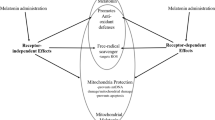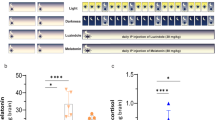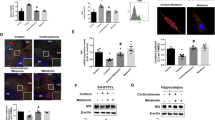Abstract
Regulation of adult hippocampal neurogenesis is influenced by circadian rhythm, affected by the manipulation of sleep, and is disturbed in animal models of affective disorders. These observations and the link between dysregulation of the circadian production of melatonin and neuropsychiatric disorders prompted us to investigate the potential role of melatonin in controlling adult hippocampal neurogenesis. In vitro, melatonin increased the number of new neurons derived from adult hippocampal neural precursor cells in vitro by promoting cell survival. This effect was partially dependent on the activation of melatonin receptors as it could be blocked by the application of receptor antagonist luzindole. There was no effect of melatonin on cell proliferation. Similarly, in the dentate gyrus of adult C57BL/6 mice in vivo, exogenous melatonin (8 mg/kg) also increased the survival of neuronal progenitor cells and post-mitotic immature neurons. Melatonin did not affect precursor cell proliferation in vivo and also did not influence neuronal and glial cell maturation. Moreover, melatonin showed antidepressant-like effects in the Porsolt forced swim test. These results indicate that melatonin through its receptor can modulate the survival of newborn neurons in the adult hippocampus, making it the first known exogenously applicable substance with such specificity
Similar content being viewed by others
Log in or create a free account to read this content
Gain free access to this article, as well as selected content from this journal and more on nature.com
or
References
Anton-Tay F, Forray C, Ortega-Corona BG. (1988). Subneuronal fate of intracerebroventricular injected 3H-melatonin. J Pineal Res 5: 125–133.
Asayama K, Yamadera H, Ito T, Suzuki H, Kudo Y, Endo S (2003). Double blind study of melatonin effects on the sleep-wake rhythm, cognitive and non-cognitive functions in Alzheimer type dementia. J Nippon Med Sch 70: 334–341.
Babu H, Cheung G, Kettenmann H, Palmer TD, Kempermann G (2007). Enriched monolayer precursor cell cultures from micro-dissected adult mouse dentate gyrus yield functional granule cell-like neurons. PLoS ONE 2: e388.
Banasr M, Soumier A, Hery M, Mocaer E, Daszuta A (2006). Agomelatine, a new antidepressant, induces regional changes in hippocampal neurogenesis. Biol Psychiatry 59: 1087–1096.
Bellon A, Ortiz-Lopez L, Ramirez-Rodriguez G, Anton-Tay F, Benitez-King G. (2007). Melatonin induces neuritogenesis at early stages in N1E-115 cells through actin rearrangements via activation of protein kinase C and Rho-associated kinase. J Pineal Res 42: 214–221.
Benitez-King G. (2006). Melatonin as a cytoskeletal modulator: implications for cell physiology and disease. J Pineal Res 40: 1–9.
Benitez-King G, Hernandez ME, Tovar R, Ramirez G (2001). Melatonin activates PKC-alpha but not PKC-epsilon in N1E-115 cells. Neurochem Int 39: 95–102.
Benitez-King G, Huerto-Delgadillo L, Anton-Tay F (1990). Melatonin effects on the cytoskeletal organization of MDCK and neuroblastoma N1E-115 cells. J Pineal Res 9: 209–220.
Benitez-King G, Huerto-Delgadillo L, Anton-Tay F (1993). Binding of 3H-melatonin to calmodulin. Life Sci 53: 201–207.
Brandt MD, Jessberger S, Steiner B, Kronenberg G, Reuter K, Bick-Sander A et al (2003). Transient calretinin expression defines early postmitotic step of neuronal differentiation in adult hippocampal neurogenesis of mice. Mol Cell Neurosci 24: 603–613.
Brusco LI, Marquez M, Cardinali DP. (2000). Melatonin treatment stabilizes chronobiologic and cognitive symptoms in Alzheimer's disease. Neuro Endocrinol Lett 21: 39–42.
Cleveland DW, Fischer SG, Kirschner MW, Laemmli UK. (1977). Peptide mapping by limited proteolysis in sodium dodecyl sulfate and analysis by gel electrophoresis. J Biol Chem 252: 1102–1106.
Conti A, Maestroni GJ. (1996). HPLC validation of a circadian melatonin rhythm in the pineal gland of inbred mice. J Pineal Res 20: 138–144.
Conti L, Cattaneo E. (2005). Controlling neural stem cell division within the adult subventricular zone: an APPealing job. Trends Neurosci 28: 57–59.
Darcourt G, Souetre E, Pringuey D, Robert P, Feuillade P, Belugou JL (1992). Disorders of circadian rhythms in depression. Encephale 18: 473–478.
Dubocovich ML. (2007). Melatonin receptors: role on sleep and circadian rhythm regulation. Sleep Med 8 Suppl(3): 34–42.
Dubocovich ML, Hudson RL, Sumaya IC, Masana MI, Manna E (2005). Effect of MT1 melatonin receptor deletion on melatonin-mediated phase shift of circadian rhythms in the C57BL/6 mouse. J Pineal Res 39: 113–120.
Duman RS. (2004). Depression: a case of neuronal life and death? Biol Psychiatry 56: 140–145.
Eisch AJ, Cameron HA, Encinas JM, Meltzer LA, Ming GL, Overstreet-Wadiche LS (2008). Adult neurogenesis, mental health, and mental illness: hope or hype? J Neurosci 28: 11785–11791.
Eser D, Baghai TC, Moller HJ (2007). Evidence of agomelatine's antidepressant efficacy: the key points. Int Clin Psychopharmacol 22 Suppl(2): S15–S19.
Ge S, Yang CH, Hsu KS, Ming GL, Song H (2007). A critical period for enhanced synaptic plasticity in newly generated neurons of the adult brain. Neuron 54: 559–566.
Guzman-Marin R, Suntsova N, Bashir T, Nienhuis R, Szymusiak R, McGinty D. (2008). Rapid eye movement sleep deprivation contributes to reduction of neurogenesis in the hippocampal dentate gyrus of the adult rat. Sleep 31: 167–175.
Guzman-Marin R, Suntsova N, Methippara M, Greiffenstein R, Szymusiak R, McGinty D. (2005). Sleep deprivation suppresses neurogenesis in the adult hippocampus of rats. Eur J Neurosci 22: 2111–2116.
Holmes A, Yang RJ, Murphy DL, Crawley JN (2002). Evaluation of antidepressant-related behavioral responses in mice lacking the serotonin transporter. Neuropsychopharmacology 27: 914–923.
Holmes MM, Galea LA, Mistlberger RE, Kempermann G (2004). Adult hippocampal neurogenesis and voluntary running activity: circadian and dose-dependent effects. J Neurosci Res 76: 216–222.
Jacobs BL (2002). Adult brain neurogenesis and depression. Brain Behav Immun 16: 602–609.
Kempermann G (2008). The neurogenic reserve hypothesis: what is adult hippocampal neurogenesis good for? Trends Neurosci 31: 163–169.
Kempermann G, Gast D, Kronenberg G, Yamaguchi M, Gage FH (2003). Early determination and long-term persistence of adult-generated new neurons in the hippocampus of mice. Development 130: 391–399.
Kempermann G, Jessberger S, Steiner B, Kronenberg G (2004). Milestones of neuronal development in the adult hippocampus. Trends Neurosci 27: 447–452.
Kempermann G, Krebs J, Fabel K (2008). The contribution of failing adult hippocampal neurogenesis to psychiatric disorders. Curr Opin Psychiatry 21: 290–295.
Kempermann G, Kronenberg G (2003). Depressed new neurons?—Adult hippocampal neurogenesis and a cellular plasticity hypothesis of major depression. Biol Psychiatry 54: 499–503.
Kilic E, Kilic U, Bacigaluppi M, Guo Z, Abdallah NB, Wolfer DP et al (2008). Delayed melatonin administration promotes neuronal survival, neurogenesis and motor recovery, and attenuates hyperactivity and anxiety after mild focal cerebral ischemia in mice. J Pineal Res 45: 142–148.
Kim MJ, Kim HK, Kim BS, Yim SV (2004). Melatonin increases cell proliferation in the dentate gyrus of maternally separated rats. J Pineal Res 37: 193–197.
Kong X, Li X, Cai Z, Yang N, Liu Y, Shu J et al (2008). Melatonin regulates the viability and differentiation of rat midbrain neural stem cells. Cell Mol Neurobiol 28: 569–579.
Liu RY, Zhou JN, van Heerikhuize J, Hofman MA, Swaab DF (1999). Decreased melatonin levels in postmortem cerebrospinal fluid in relation to aging, Alzheimer's disease, and apolipoprotein E-epsilon4/4 genotype. J Clin Endocrinol Metab 84: 323–327.
Millan MJ, Brocco M, Gobert A, Dekeyne A (2005). Anxiolytic properties of agomelatine, an antidepressant with melatoninergic and serotonergic properties: role of 5-HT2C receptor blockade. Psychopharmacology (Berl) 177: 448–458.
Moriya T, Horie N, Mitome M, Shinohara K (2007). Melatonin influences the proliferative and differentiative activity of neural stem cells. J Pineal Res 42: 411–418.
Mueller AD, Pollock MS, Lieblich SE, Epp JR, Galea LA, Mistlberger RE. (2008). Sleep deprivation can inhibit adult hippocampal neurogenesis independent of adrenal stress hormones. Am J Physiol Regul Integr Comp Physiol 294: R1693–R1703.
Overstreet DH, Pucilowski O, Retton MC, Delagrange P, Guardiola-Lemaitre B. (1998). Effects of melatonin receptor ligands on swim test immobility. Neuroreport 9: 249–253.
Pacchierotti C, Iapichino S, Bossini L, Pieraccini F, Castrogiovanni P. (2001). Melatonin in psychiatric disorders: a review on the melatonin involvement in psychiatry. Front Neuroendocrinol 22: 18–32.
Palmer TD, Takahashi J, Gage FH (1997). The adult rat hippocampus contains premordial neural stem cells. Mol Cell Neurosci 8: 389–404.
Papp M, Gruca P, Boyer PA, Mocaer E (2003). Effect of agomelatine in the chronic mild stress model of depression in the rat. Neuropsychopharmacology 28: 694–703.
Plumpe T, Ehninger D, Steiner B, Klempin F, Jessberger S, Brandt M et al (2006). Variability of doublecortin-associated dendrite maturation in adult hippocampal neurogenesis is independent of the regulation of precursor cell proliferation. BMC Neurosci 7: 77.
Porsolt RD, Anton G, Blavet N, Jalfre M (1978). Behavioural despair in rats: a new model sensitive to antidepressant treatments. Eur J Pharmacol 47: 379–391.
Porsolt RD, Bertin A, Jalfre M (1977). Behavioral despair in mice: a primary screening test for antidepressants. Arch Int Pharmacodyn Ther 229: 327–336.
Porsolt RD, Le Pichon M, Jalfre M (1977). Depression: a new animal model sensitive to antidepressant treatments. Nature 266: 730–732.
Qian X, Shen Q, Goderie SK, He W, Capela A, Davis AA et al (2000). Timing of CNS cell generation: a programmed sequence of neuron and glial cell production from isolated murine cortical stem cells. Neuron 28: 69–80.
Ramirez-Rodriguez G, Meza I, Hernandez ME, Castillo A, Benitez-King G (2003). Melatonin induced cyclic modulation of vectorial water transport in kidney-derived MDCK cells. Kidney Int 63: 1356–1364.
Reiter RJ (1991). Melatonin: the chemical expression of darkness. Mol Cell Endocrinol 79: C153–C158.
Reiter RJ (1998a). Cytoprotective properties of melatonin: presumed association with oxidative damage and aging. Nutrition 14: 691–696.
Reiter RJ (1998b). Oxidative damage in the central nervous system: protection by melatonin. Prog Neurobiol 56: 359–384.
Reiter RJ, Tan DX, Maldonado MD (2005). Melatonin as an antioxidant: physiology versus pharmacology. J Pineal Res 39: 215–216.
Reiter RJ, Tan DX, Manchester LC, Pilar Terron M, Flores LJ, Koppisepi S (2007). Medical implications of melatonin: receptor-mediated and receptor-independent actions. Adv Med Sci 52: 11–28.
Sahay A, Hen R (2007). Adult hippocampal neurogenesis in depression. Nat Neurosci 10: 1110–1115.
Skinner DC, Malpaux B (1999). High melatonin concentrations in third ventricular cerebrospinal fluid are not due to Galen vein blood recirculating through the choroid plexus. Endocrinology 140: 4399–4405.
Soto-Vega E, Meza I, Ramirez-Rodriguez G, Benitez-King G (2004). Melatonin stimulates calmodulin phosphorylation by protein kinase C. J Pineal Res 37: 98–106.
Tan DX, Reiter RJ, Manchester LC, Yan MT, El-Sawi M, Sainz RM et al (2002). Chemical and physical properties and potential mechanisms: melatonin as a broad spectrum antioxidant and free radical scavenger. Curr Top Med Chem 2: 181–197.
Thomas RM, Peterson DA (2008). Even neural stem cells get the blues: evidence for a molecular link between modulation of adult neurogenesis and depression. Gene Expr 14: 183–193.
Vitte PA, Harthe C, Lestage P, Claustrat B, Bobillier P (1988). Plasma, cerebrospinal fluid, and brain distribution of 14C-melatonin in rat: a biochemical and autoradiographic study. J Pineal Res 5: 437–453.
Vivien-Roels B, Malan A, Rettori MC, Delagrange P, Jeanniot JP, Pevet P (1998). Daily variations in pineal melatonin concentrations in inbred and outbred mice. J Biol Rhythms 13: 403–409.
Acknowledgements
This work was supported by VolkswagenStiftung. GBK was supported by CONACYT (Grant no. 46593-M). We thank Sebastian Mirochnic for helpful discussions, and Ruth Zarmsftorff, Signe Knespel, Patricia Chimal-Cortes for technical assistance.
Author information
Authors and Affiliations
Corresponding author
Additional information
Conflict of Interest
No pharmaceutical company was involved in funding the present research. Gerd Kempermann has received compensation over the last 3 years from Glaxo Smith Kline, Novartis Foundation, and Tecan as honorarium for lectures. Gloria Benitez-King, Gerardo Ramirez-Rodriguez, Harish Babu, and Friederike Klempin have received, except for income received from my primary employer, no financial support or compensation from any individual or corporate entity for research or professional services in any of the previous 3 years, and no financial holdings that could be perceived as constituting a potential conflict of interest.
Supplementary Information accompanies the paper on the Neuropsychopharmacology website (http://www.nature.com/npp)
Rights and permissions
About this article
Cite this article
Ramírez-Rodríguez, G., Klempin, F., Babu, H. et al. Melatonin Modulates Cell Survival of New Neurons in the Hippocampus of Adult Mice. Neuropsychopharmacol 34, 2180–2191 (2009). https://doi.org/10.1038/npp.2009.46
Received:
Revised:
Accepted:
Published:
Issue date:
DOI: https://doi.org/10.1038/npp.2009.46
Keywords
This article is cited by
-
Pineal gland dysfunction in Alzheimer’s disease: relationship with the immune-pineal axis, sleep disturbance, and neurogenesis
Molecular Neurodegeneration (2019)
-
Interaction of melatonin and Bmal1 in the regulation of PI3K/AKT pathway components and cellular survival
Scientific Reports (2019)
-
On the central role of mitochondria dysfunction and oxidative stress in Alzheimer’s disease
Neurological Sciences (2019)
-
Melatonin in Alzheimer’s Disease: A Latent Endogenous Regulator of Neurogenesis to Mitigate Alzheimer’s Neuropathology
Molecular Neurobiology (2019)
-
Pineal-dependent increase of hypothalamic neurogenesis contributes to the timing of seasonal reproduction in sheep
Scientific Reports (2018)



